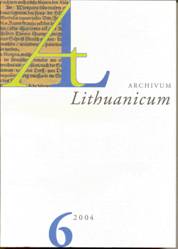Christiano Gottliebo Mielcke's "Kûlikas" - klasicistinio vertimo pavyzdys
The Thresher (1800) by Christian Gottlieb Mielcke - An example of a classicist style translation
Author(s): Žavinta SidabraitėSubject(s): Theoretical Linguistics, Historical Linguistics, Baltic Languages, 19th Century, Translation Studies
Published by: Lietuvių Kalbos Institutas
Keywords: The Thresher; 19th century; Translation; Classicist style; Christian Gottlieb Mielcke;
Summary/Abstract: In the chapter on poetics of the Lithuanian grammar, which was published in Königsberg (Karaliauèius) in 1800, Christian Gottlieb Mielcke published his own translation of Der Drescher (The Thresher), a fable by Christian Fürchtegott Gellert. According to Mielcke's plan, The Thresher was supposed to become an example of a proper translation of a piece of poetry into Lithuanian. Having rejected the possibility of word-for-word translation and influenced by the nascent ideas of Romanticism, Mielcke was the first in a Lithuanian cultural milieu to write about the necessity of taking into consideration the "spirit of the language". This was the most apparent in the phraseological units and figurative phrases that could not be translated literally. When translating, Mielcke did not aim to reproduce the original precisely. Having the audience for his translation'a Lithuanian peasant-in mind, he consciously tried to adjust the fable by Gellert to the life and language of a peasant by modifying the theme and the means of expression. He would not object to expurgating certain episodes and original parts and he would use stylistically marked spoken language and transform versification. In general, the translation by Mielcke satisfied the requirements of a rather free classicist style translation.
Journal: Archivum Lithuanicum
- Issue Year: 2004
- Issue No: 06
- Page Range: 117-130
- Page Count: 14
- Language: Lithuanian

